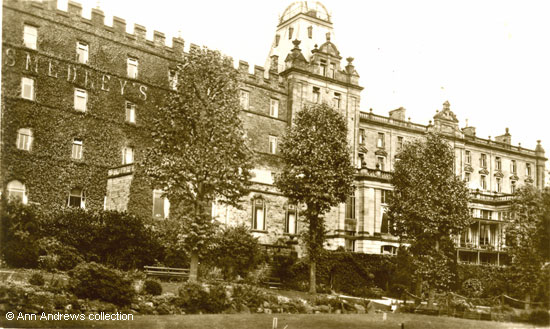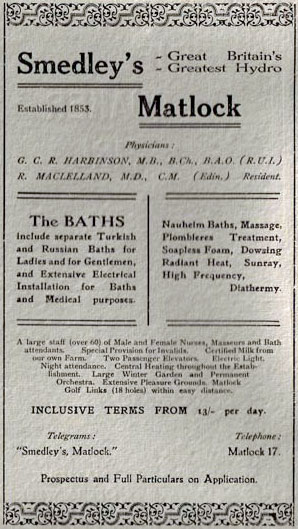|
Images Index> 20th & 21st Century, Matlock> This page |
| Matlock: Smedley's Hydro, The Inter-War Years |
| Matlock : Twentieth Century Photographs, Postcards, Engravings & Etchings |
|
||||||||||||
The senior staff and people running the hydro in the 1920s were almost unchanged from those who were there in 1906[2]. However, Henry Challand who was the managing director for many years died suddenly on 29 June 1925. He was almost 60, and at his funeral the Congregational Church Minister, Rev. G. H. Russell, noted that he had been in Matlock for nearly half a century[3]. Ernest Wilmot was the secretary and George Harbison and Robert MacLelland were the two physicians. There were now electric passenger lifts connecting all the floors and in the basement were "hairdressing salons for ladies and gentlemen, complete with all modern appliances. Smedley's was "equally suited to the requirements of the chronic invalid, or the merely tired business man or woman desirous of a change of air or environment[4]".
The family photograph below shows the front of Smedley's Hydro
and the Winter Garden, which, according to "Truth", had
a well sprung dance floor[4].
The hydro's public rooms led off from the main lounge-corridor;
they extended for one hundred yards along the front of the building
from the entrance hall to the Winter Garden and fernery[4].
The picture was taken on a snowy day in the 1920s, almost certainly
by Jim Kempster, the manager's son in law. Someone
has even begun to make a snow man or a giant snowball! The spire
(shown top, left on the photo) belongs to the United Methodist
Free Chapel that John Smedley built in the hydro's grounds. It
was later converted into an engine house.
Several long serving members of staff died in the 1930s including the head bathman, Mr. Henstock. Dr. George Casement Reid Harbinson had been on the medical staff for the previous 40 years and had been the consulting physician for 35 years at the time of his death in 1939. A former visitor to the hydro who passed away in 1936 was the Communist M.P. for North Battersea, Mr. Shapwiji D. Saklatvala. He had stayed at Smedley's for three months before the first war, working as secretary to Mr. Rayton Tata. He befriended and subsequently married one of the domestic staff, Miss Sarah E. Marsh[6]. The local paper recount a rather endearing story about him offering to buy her a bicycle, a gift she refused. So her future husband organised a raffle, gave free tickets to male members of Smedley's staff and when Miss Marsh won her bicycle it proved to be a lady's model[7]! One of the residents who died at Smedley's just before the outbreak of the Second World War was a well-known and wealthy Cumberland ship owner, Mr. Richard Williamson, who had lived at the Hydro for some 14 years[8].
The hydro's residents had to leave and the building had to prepared quickly for its new occupants. Yet despite all the evictions and upheaval, the Army did not move in for six months, although they had made the alterations necessary for the change from hospital and hotel to an Army school relatively quickly. The changes included the installation of hundreds of telephones. There was just one civil servant taking care of a building on which no rates were seemingly being paid. The hydro was to remain in Army hands for the duration of the war and was used as a School of Military Intelligence. Amongst those who trained at Smedley's were the writers Evelyn Waugh and Anthony Powell as well as the actor Dirk Bogarde[11]. Keith Taylor goes into some detail about the hydro in WW2, and mentions the soldiers being marched up the hill from the station on their arrival[12]. Hush, hush or not, group photographs of soldiers at the hydro and sightings of them being marched through the town in full view were hardly a secret, even if the locals were forbidden to mention it! Smedley's was derequisitioned on 1 Feb 1946[13].
|
||||||||||||
View Smedley's Christmas and New Year Menus & Programmes:
|
||||||||||||
|
1. "The South Front, Smedley's Hydro, Matlock". Published by Bridge House, No. S19123. Real Photo Series. Printed in England. Unused. Another posted 1949 but it is likely that this picture was published before WW2. 2. Advertisement from Ward Lock & Co's "Matlock, Dovedale, Bakewell and South Derbyshire", Illustrated Guide Books of England and Wales (1926-7). 3. Photograph of Smedley's scanned by and © Jane Leslie from her personal collection especially for this web site. 4. "Matlock. Smedley's Hydro". Published by Photochrom Co. Ltd., Graphic Works, Tunbridge Wells, No.62695. Exclusive Copyright/Real Photo. Made in Tunbridge Wells. Unused. 5. "The Terrace, Smedley's Hydro, Matlock". No. S14065. Posted 13th September 1927. Image kindly donated by Photo-Ark © 2003. 6. Advertisement from Ward Lock & Co's "Matlock, Dovedale, Bakewell and South Derbyshire", Illustrated Guide Books of England and Wales (1932-3). 7. Advertisement from Matock & District's Operatic Society programme © Susan Tomlinson collection. See their programmes 8. Advertising leaflet for Smedleys Hydro, 1938 © Jane Leslie collection. Items 1, 2, 4 and 6. in the collection of and provided by and © Ann Andrews. Written, researched by and © Ann Andrews. Intended for personal use only. |
||||||||||||
References (coloured hyperlinks are to transcripts and information elsewhere on this web site): [1] Peach, Lawrence du Garde (1954) "John Smedley of Matlock and his Hydro", Bemrose Publicity Co.: Derby & London. [2] "Kelly's Derbyshire Directory", 1925. [3] "Derby Daily Telegraph", 29 June 1925 and "Derby Daily Telegraph", 2 July 1925. Reports of death and funeral. Henry Challand can be found in the 1891 census | the 1901 census | Kelly's 1891 Directory | Kelly's 1895 Directory | Kelly's 1899 Directory |. Also as M.D. of Smedleys in Kelly's 1908 Directory | Kelly's 1912 Directory | Kelly's 1916 Directory | [4] "Truth" Special Publicity Supplement - No.77. The Quest of Health. 25th Aug., 1926. Printed for the Proprietors by St. Clement's Press, Ltd., Portugal Street, Kingsway, W.C.2 and Published by the Advertising Department of the Truth Publishing Co. Ltd at 10 Cartaret Street, Westminster, S.W.1. Also see: Smedley's Hydro & Grounds, Matlock, 1926 - from "Truth" | Smedley's Hydro Grounds, Matlock, 1926 - from "Truth". [5] "Derby Daily Telegraph", 1 April 1931. [6] "Sheffield Independent", 18 January 1936. Miss Marsh was the daughter of Henry Marsh, a gritstone quarry stone cutter, of Tansley and later of Oakerthorpe although they were living in Oldham in 1911. She was born at Tansley. [7] Derbyshire Times, 24 January 1936. Notes by the Way. [8] "Derby Daily Telegraph", 10 April 1939. Mr. Williamson died intestate aged 83. He was noted as a generous benefactor of several Matlock charities. [9] "Derby Daily Telegraph", 26 February 1940. Captain Douglas explains why he resigned. [10] "Derbyshire Times", 1 December 1939. Matlock's dilemma. Preparations For Government Officials Who Have Not Come. Decision Needed. [11] Barton, David A. "Around Matlock in Old Photographs", (1998) part of a series called "Britain in Old Photographs", Budding Books, ISBN 1-84015-076-9. David's book contains four photos from the Army years; three were of various groups of trainees and officers whilst a fourth is of the soldiers marching down the street. This last was presumably of local recruits. [12] Taylor, Keith (2010) "Matlock and the Great War 1914 - 1919", Country Books/Ashridge Press. ISBN 978 1 906789 38 1. [13] "Derbyshire Times", 21 December 1945. |
||||||||||||



















 Read the next stage in the hydro's
history,
Read the next stage in the hydro's
history, 









